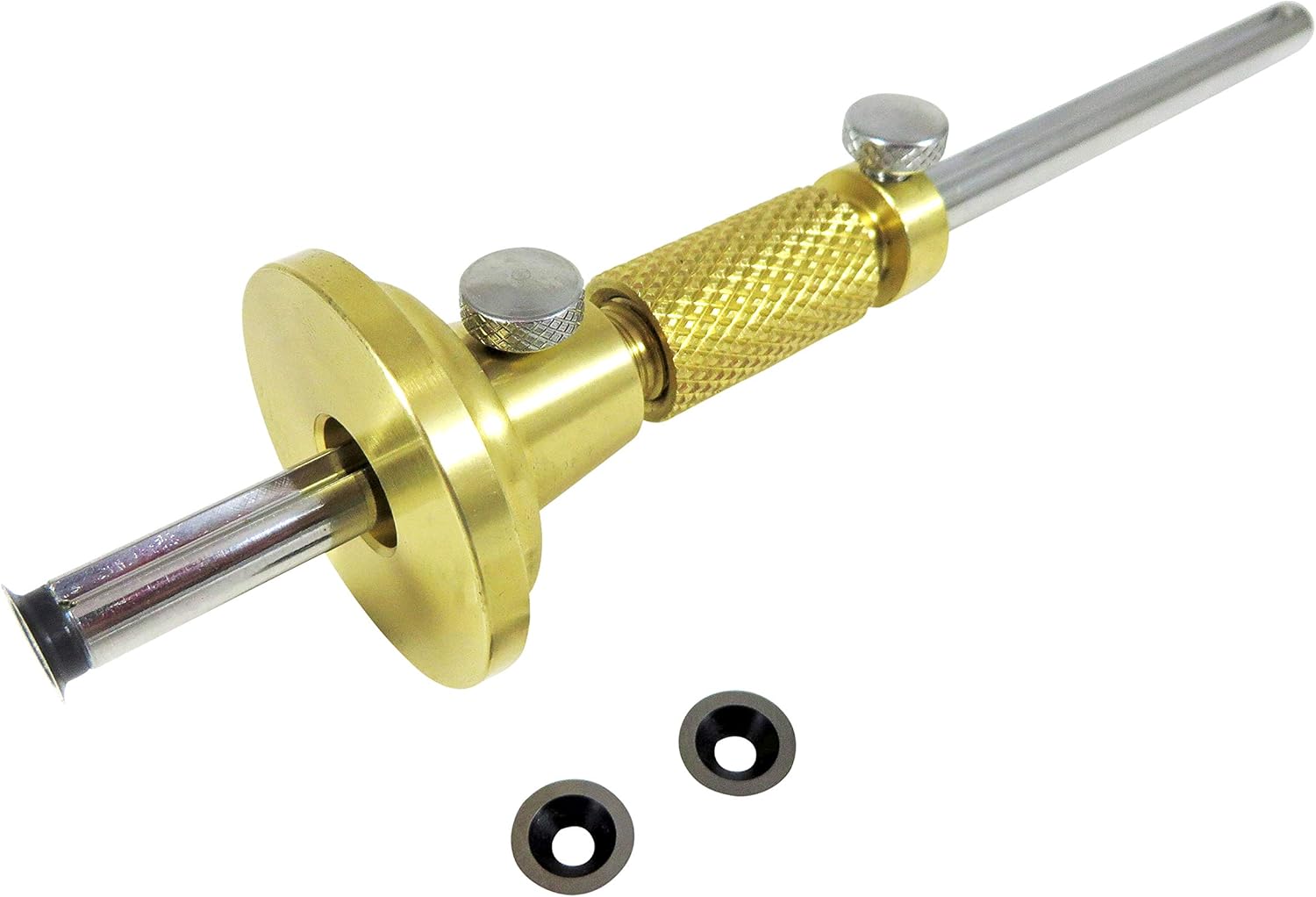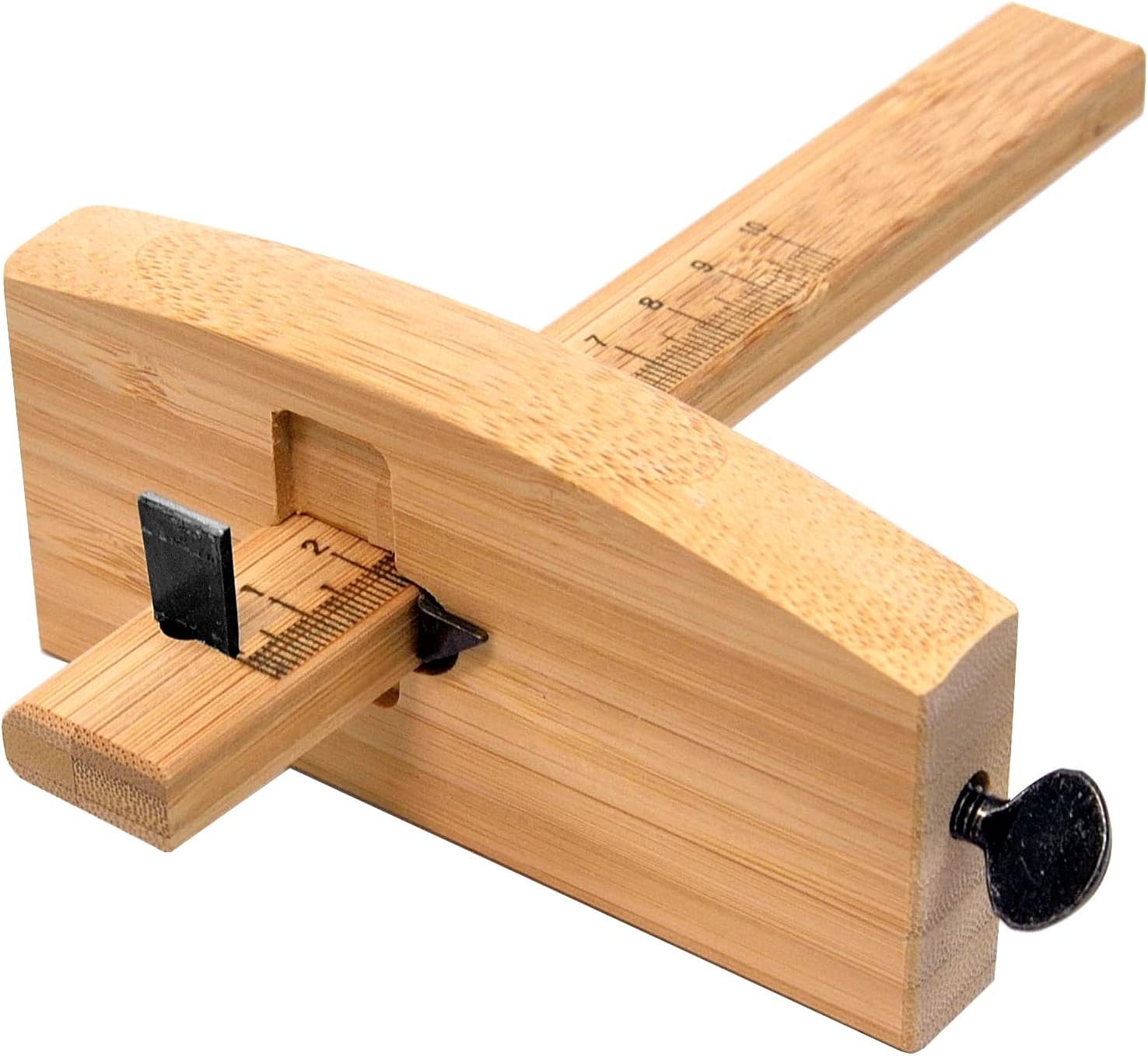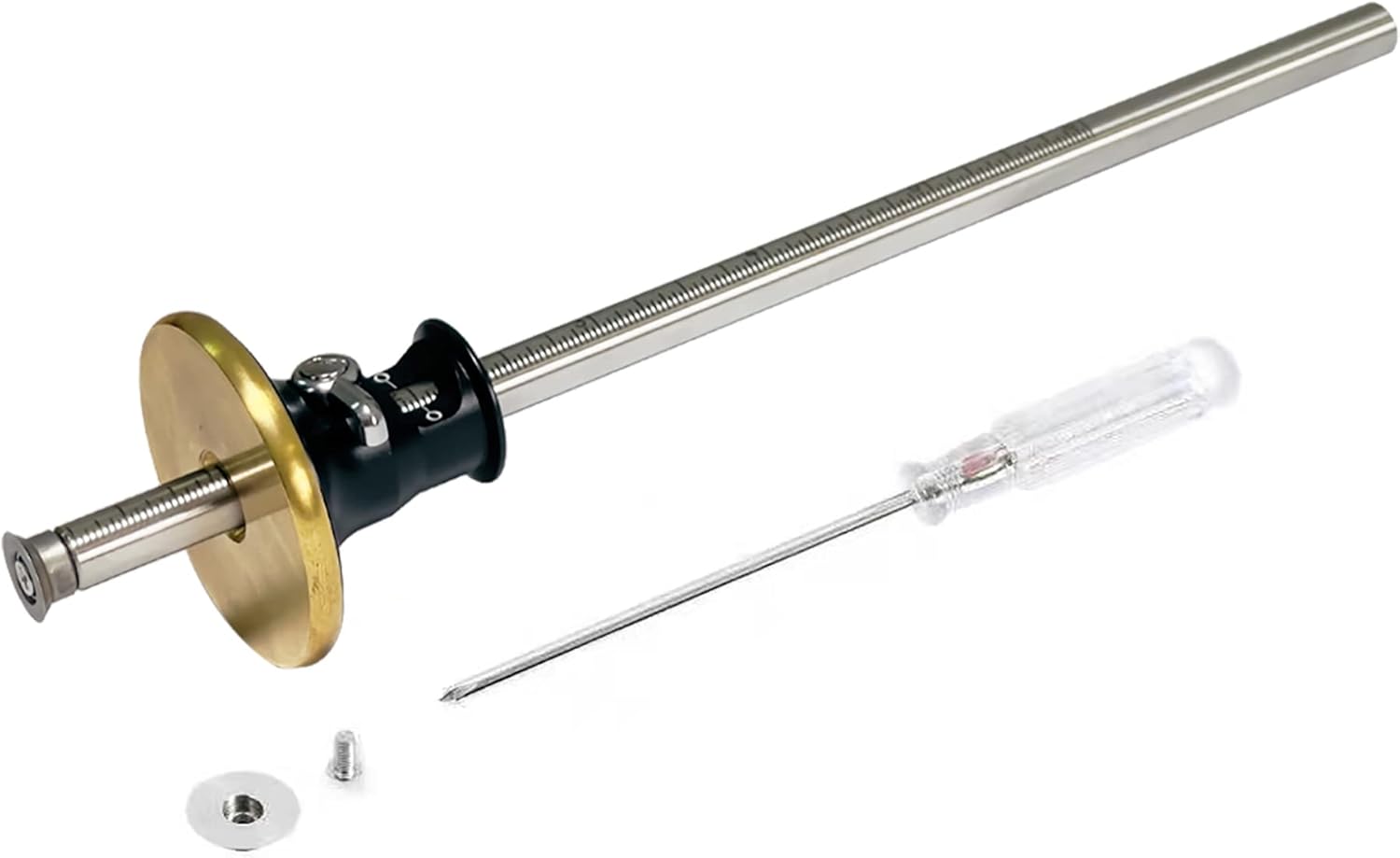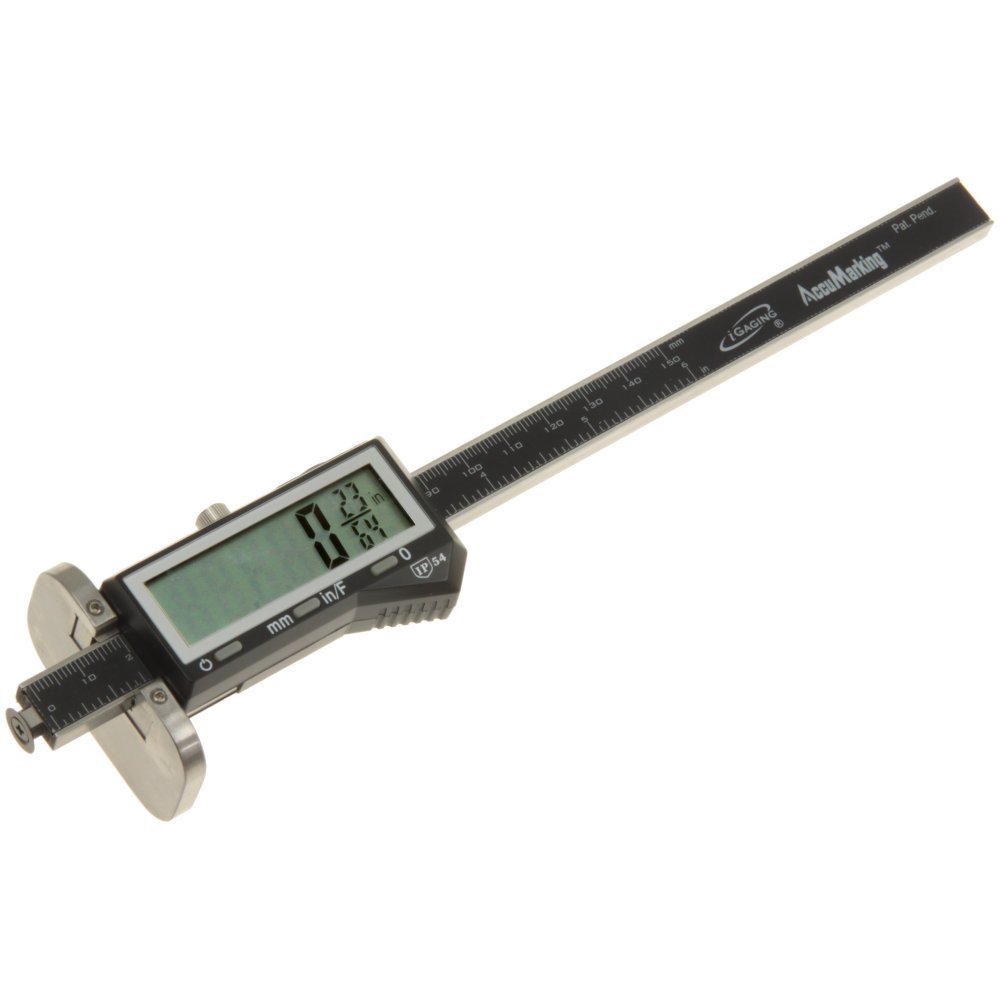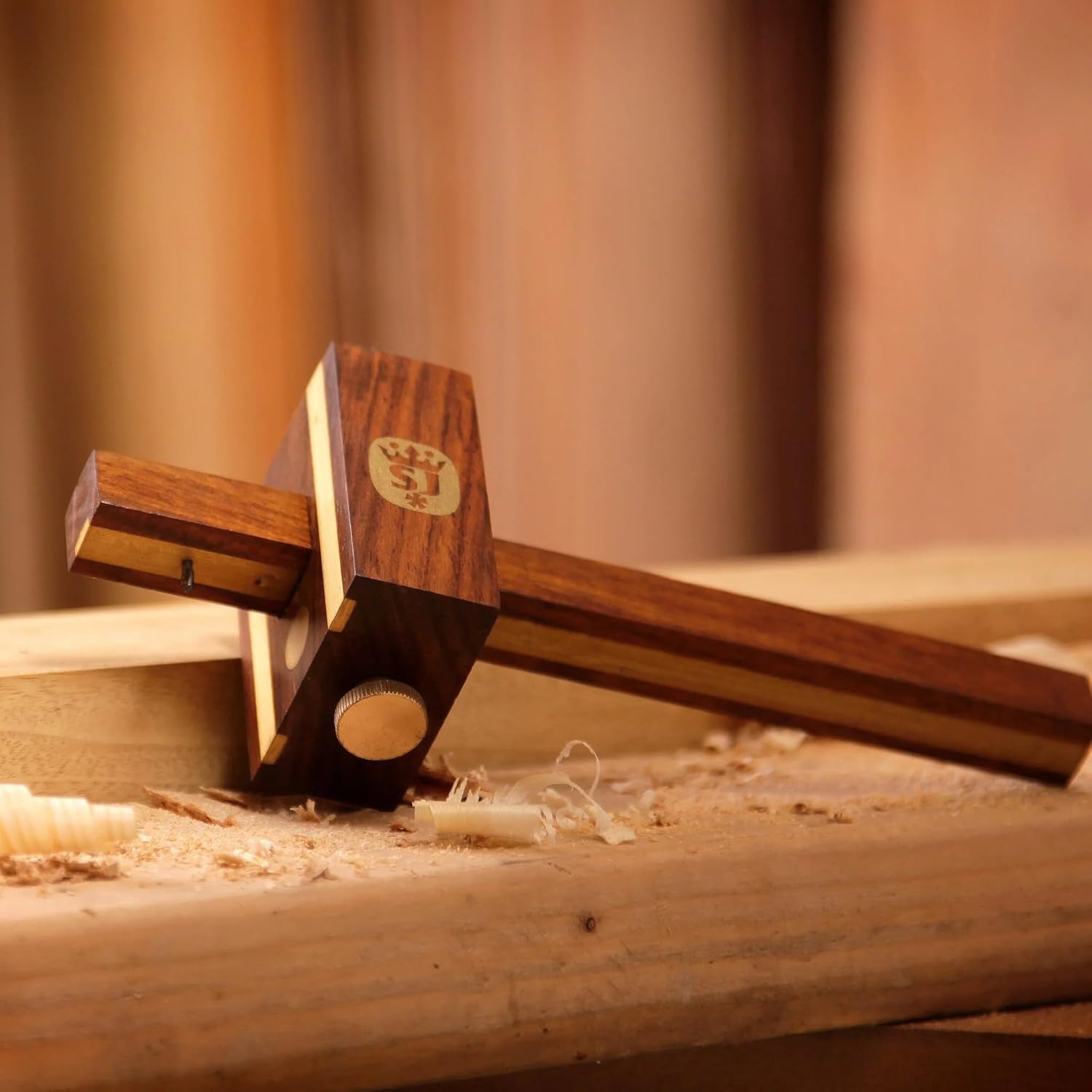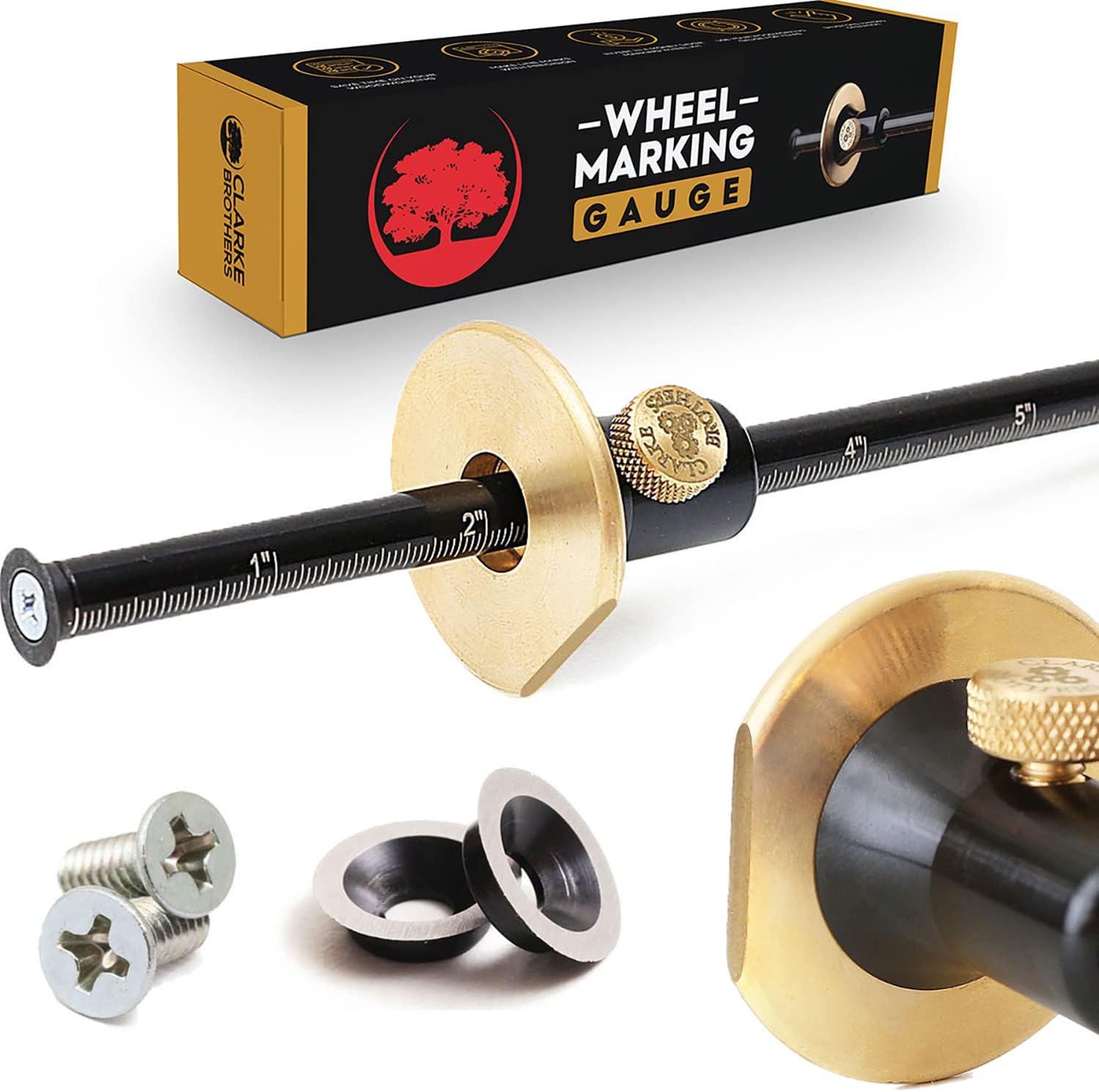Marking Gauges for Precise Layout Work
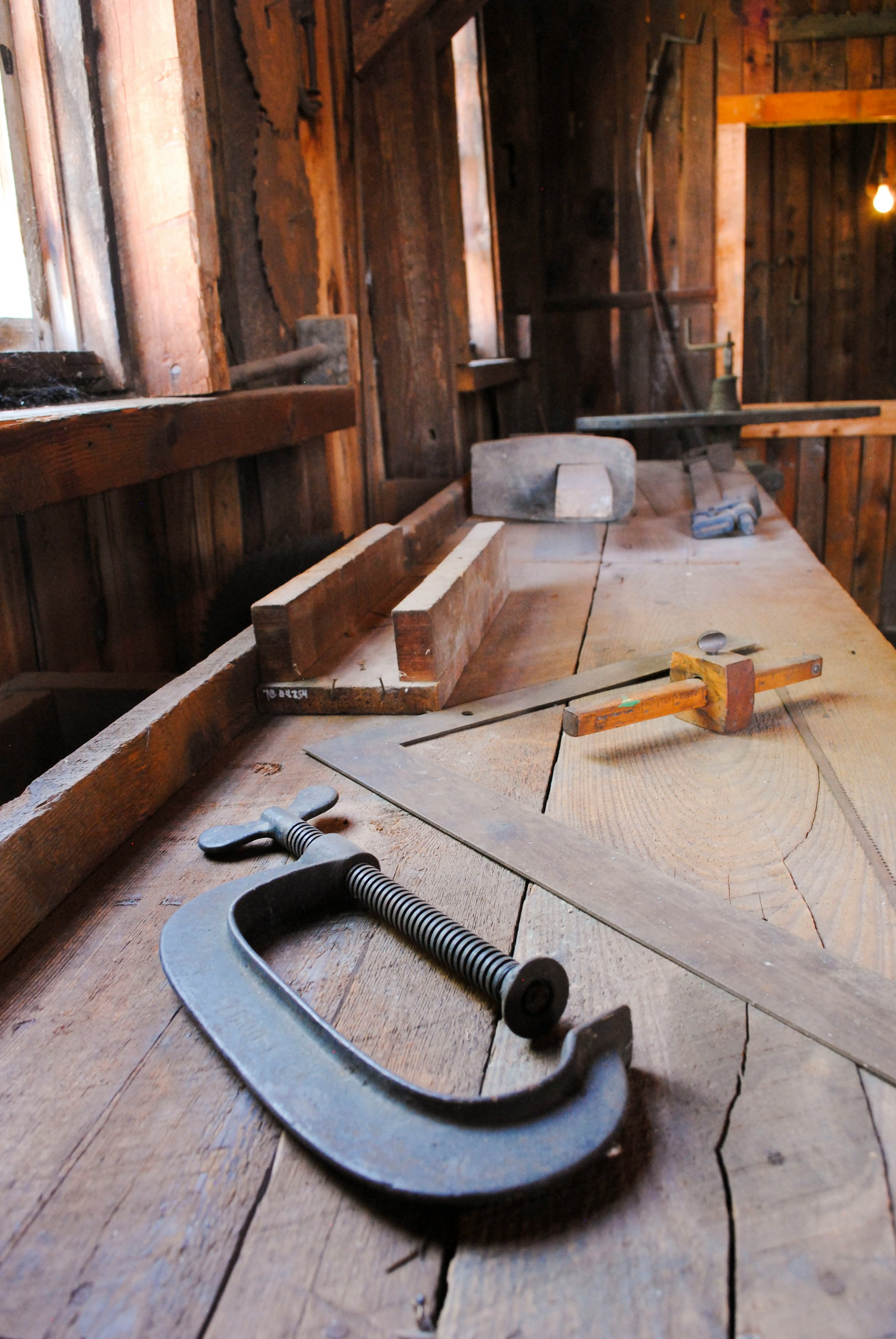
There's something deeply satisfying about a well-marked line on wood. Not the hasty pencil scratch that wobbles as you drag it along, but the crisp, consistent score that tells you exactly where your cut needs to be. That precision comes from a marking gauge, and finding the right one matters more than you might think.
A marking gauge consists of a beam with a sharp marking implement at one end and an adjustable fence at the other. The fence slides along the beam and locks at your desired distance from the edge. Run it parallel to your workpiece, and you get a line that stays exactly where you set it, whether you're marking tenons, dovetails, or just need to know where to make a cut.
The tool itself hasn't changed much in concept over centuries, but modern versions have evolved. Some use traditional pins, others employ cutting wheels, and a few have gone digital. The material, the locking mechanism, the type of marking implement - these details determine whether you'll reach for the tool constantly or let it gather dust in a drawer.
For joinery work especially, a marking gauge becomes essential. When you're scribing lines for joining two pieces of material together, setting the gauge to the right distance from the edge and running that sharp point or wheel along creates the reference line you need. Get those lines right, and the joint fits. Miss by a fraction, and you're reaching for the wood filler.
What We're Looking At
We've gathered marking gauges that span different approaches to the same fundamental task. You'll find traditional Japanese tools that have been made the same way for generations, precision wheels with brass bodies that feel substantial in hand, and even digital options that display measurements down to thousandths of an inch.
The right marking gauge isn't necessarily the most expensive or the most traditional. It's the one that matches how you actually work. Some of these tools excel at fine furniture making, others handle construction-grade work without flinching, and a few bridge both worlds with features that adapt to different tasks.
Taytools MGB Solid Brass Wheel Marking Gauge
Quick Specs:
- 1.625" solid brass micro-adjustable head
- 7" × 5/16" hardened steel grooved beam
- 3/8" retractable cutting wheel with 2 spares
- 0.6 lbs
Pick this up and you immediately notice the weight. At 0.6 pounds, it has that substantial feeling that cheaper marking gauges lack. The brass head measures 1.625 inches in diameter, which gives you a solid reference face that won't skip or chatter as you work.
The micro-adjustment feature sets this apart from simpler designs. When you need to dial in a measurement to the smallest fraction, the graduated system lets you make those tiny tweaks without fumbling. The knurled knob and tail provide good grip, and the locking mechanism holds position without slipping during use.
That grooved beam isn't just for looks. The groove helps prevent the head from rotating when you're making adjustments, which sounds minor until you've dealt with a marking gauge that spins on you mid-adjustment. The hardened steel beam handles regular shop wear without developing play in the system.
The cutting wheel retracts into the head when not in use. This protects both the blade and whatever surface the tool happens to be resting on. You get two spare cutting wheels included, which extends the working life considerably before you need to order replacements.
The brass construction means this tool will age rather than deteriorate. Over time, brass develops a patina that many woodworkers appreciate. More importantly, it won't rust or corrode, even in shops with humidity issues. The combination of materials here, brass for the body and hardened steel for the beam and cutters, creates a tool that should outlast most of what's in your workshop.
For precision woodworking where measurements matter, this gauge delivers consistent results. The micro-adjustment means you can creep up on exact dimensions rather than hoping your eye is accurate enough. That capability becomes especially valuable when you're fitting joinery that needs to be spot-on.
KAKURI Japanese Marking Gauge
Quick Specs:
- Natural bamboo body
- Japanese carbon steel blade
- 4.75" (120mm) maximum marking width
- 4.2 oz
- Blade stores inside body
This is what Japanese woodworkers call a suji kebiki, and it takes a completely different approach than wheel-based gauges. Instead of a rolling cutter, you get a fixed carbon steel blade that scores the wood as you pull it along. The bamboo body feels warm in hand, unlike the cold metal of Western-style gauges.
At 4.2 ounces, this gauge is notably lighter than brass alternatives. That reduced weight becomes an advantage during extended marking sessions. Your hand doesn't fatigue as quickly, and the tool feels less cumbersome when you're working on smaller projects where precision matters more than mass.
The blade stores inside the wooden body when not in use, sliding into a recess that keeps the edge protected and prevents accidental cuts to your hands or work surface. This design dates back generations, and it works as well now as it did a century ago. The simplicity means fewer parts to fail or lose.
Adjustment happens through a simple screw mechanism that you can operate by hand. No knurling, no fancy threads, just straightforward tightening that holds the fence where you set it. The bamboo body provides enough friction that once locked, the setting doesn't drift during use.
Japanese carbon steel holds an edge exceptionally well, but it requires more attention than stainless alternatives. A thin film of tool oil prevents rust, and occasional sharpening keeps the blade cutting cleanly. If you're already maintaining hand plane blades or chisels, adding this to your routine takes minimal extra effort.
The metric scale markings go up to 120mm, which covers most marking tasks. If you work primarily in imperial measurements, you'll need to do quick conversions, but most woodworkers who gravitate toward Japanese tools develop comfort with metric pretty quickly.
This gauge excels at marking across the grain, where a wheel cutter might want to wander. The fixed blade holds its line regardless of grain direction or wood species. That reliability makes it valuable for joinery work where your marks determine how well parts fit together.
YOSELIN Wheel Marking Gauge
Quick Specs:
- CNC-machined brass and anodized aluminum
- 8" precision-ground bar with dual scales
- Small observation window for scale reading
- 1/32" imperial and 1mm metric increments
- Includes dovetail marking jig
The observation window on this gauge solves a common frustration. Most marking gauges force you to crane your neck or adjust your viewing angle to read the scale accurately. Here, a small window positioned in the fence lets you see the measurement directly while you're adjusting, which speeds up setup and reduces errors.
CNC manufacturing shows in the tight tolerances throughout the tool. The fence slides smoothly along the bar without wobble or binding, yet locks firmly when you tighten the mechanism. This consistency matters when you're making repeated marks that need to match exactly.
The anodized aluminum resists wear and corrosion while keeping weight reasonable. Combined with the brass components, you get durability without excessive heft. The round body shape fits comfortably in your palm during use, and the smooth surfaces won't snag on material as you work.
Both imperial and metric scales appear on the 8-inch bar, with laser-engraved markings that remain legible even after years of shop use. The dual measurement system means you can work in whichever units suit your project without mental conversions or grabbing a different tool.
The included dovetail marking jig extends the tool's utility beyond basic parallel lines. This guide helps establish consistent dovetail angles, with common ratios marked for different wood types. Having this reference built into the system saves time and improves consistency when cutting multiple joints.
At 1/32" imperial resolution, this gauge handles typical woodworking tolerances comfortably. The metric side offers 1mm increments, which translates to roughly the same precision in that measurement system. For most shop tasks, this level of accuracy proves more than adequate.
The retractable wheel design protects the cutting edge when stored. The wheel withdraws into a recess in the fence face, preventing damage to the blade and to whatever surface the tool sits on. This thoughtful detail extends blade life and reduces the chance of accidental cuts when reaching into a toolbox.
iGAGING Digital Marking Gauge
Quick Specs:
- 0-6" measurement range
- 0.001" accuracy, 0.0005" resolution
- Digital display: inches, mm, 64th fractions
- IP54 dust and humidity resistance
- Stainless steel construction
- Functions as marking, depth, and height gauge
Digital readouts in the workshop divide opinion sharply. Some woodworkers consider them essential for precision work, while others view them as unnecessary complexity. This gauge makes a strong case for the former position by adding genuine utility rather than just electronic novelty.
The display shows measurements in decimal inches, millimeters, or 64th-inch fractions. That last option proves particularly valuable in woodworking, where fractional dimensions remain standard. Being able to read 5/64" directly beats converting from decimal or counting fractional divisions on a rule.
Zero-setting at any position means you can measure offsets from reference points rather than always working from the end of the scale. This flexibility speeds up layout when you're establishing multiple measurements from a common datum. The large LCD remains readable in typical shop lighting, though direct sunlight or heavy shadow can reduce visibility.
The 0.001" accuracy represents precision well beyond what most woodworking requires, but having that resolution available never hurts. When you do need to split thousandths, perhaps for metal hardware fitment or extremely tight joinery, the capability exists. For routine marking tasks, this precision provides confidence that your measurements are genuinely accurate.
IP54 rating means the gauge resists dust and water splashes. Not submersion, but enough protection for workshop environments where sawdust fills the air and occasional moisture appears on surfaces. This durability rating suggests the electronics should survive conditions that would damage unprotected digital tools.
The removable hardened alloy wheel handles both hardwoods and softwoods effectively. When the wheel wears, replacement involves unscrewing the old one and installing a new cutter, a process that takes seconds. Having a removable wheel also lets you swap to different profile cutters if you find specialty options.
The stainless steel construction resists corrosion and provides smooth travel along the beam. The solid fence measures large enough to register reliably against workpiece edges without tipping or binding. Combined with the ultra-smooth mechanism, this creates a tool that glides along stock with minimal effort.
Three tools in one housing adds value. Beyond marking parallel lines, this gauge functions as a depth gauge for mortises or dados, and as a height gauge for setting fences or blade heights. Having one tool handle multiple measurement tasks reduces clutter and means you're more likely to have the right instrument at hand when you need it.
Battery life becomes a consideration with any digital tool. The included spare battery helps, but if you're the type who forgets to replace batteries until the tool stops working, keep spares on hand. The gauge does feature an auto-shutoff to preserve battery life during idle periods.
JessEm Wood Sabre Marking Gauge
Quick Specs:
- Wood sabre design for balanced pressure
- 0-6" range with micro adjuster
- A2 tool steel blade hardened to 60 RC
- 3" stainless steel reference face
- Graduated collar: 1/256" adjustment resolution
- Stainless steel and 6061 aluminum construction
The curved sabre shape distinguishes this gauge from conventional rectangular designs. This ergonomic approach distributes pressure more evenly across the reference face, which reduces the tendency for the gauge to rock or tip during use. The result feels more controlled, especially when marking longer pieces where maintaining consistent contact becomes challenging.
That micro adjuster deserves attention. The laser-engraved markings appear at half-inch intervals, with the fine adjustment providing 1/16" per full rotation. This two-stage system lets you get close quickly with the main scale, then dial in exact measurements using the adjuster. The graduated collar refines positioning down to 1/256", which enters territory where wood movement might exceed your measurement precision.
A2 tool steel blade material means serious edge retention. Hardened to 60 Rockwell, this cutter stays sharp through extended use and handles both softwoods and hardwoods without difficulty. When the blade does need attention, A2 steel responds well to sharpening, though its hardness requires appropriate stones or abrasives.
The blade retracts below the reference face when not in use, protecting both the edge and surrounding surfaces. This safety feature also means you can set the gauge down without worrying about inadvertent marks on your bench or accidentally dulling the blade against something hard.
That 3-inch wide reference face provides exceptional stability. Where smaller fences might tip or chatter on uneven stock, this broad face maintains consistent contact. The face sits 3/4" below the blade, creating clearance that allows you to see your work clearly while maintaining positive registration against the workpiece edge.
The sight window on the gauge face references at 1/16" increments, giving you visual confirmation of coarse positioning before you engage the micro adjuster for final tweaking. This dual-level feedback system reduces the chance of major setting errors while providing the precision needed for exacting work.
Stainless steel and 6061 aluminum combine corrosion resistance with structural rigidity. The materials choice means this gauge should maintain its precision over years of use, with minimal risk of rust or degradation even in humid shop environments. The smooth surfaces clean easily, and sawdust doesn't pack into mechanisms or hide measurement markings.
At 1.4 pounds, this gauge carries noticeably more mass than lighter alternatives. That weight contributes to stability during use but might fatigue your hand during extended marking sessions. The trade-off between mass-based stability and user comfort becomes a personal preference that varies by individual and by task.
Spear & Jackson CMKG Marking Gauge
Quick Specs:
- Rosewood-stained hardwood block
- Brass wear plates on working face
- Round brass bar and locking screw
- Internal brass thread
- 8" beam length
- Traditional pin-style marker
This represents the marking gauge design that carpenters have used for generations. No wheels, no digital readouts, just a hardwood beam with a steel pin at one end and a wooden fence that slides along it. The simplicity means fewer parts to break, lose, or misalign over time.
Rosewood stain gives the hardwood block a rich appearance while helping seal the wood against moisture and handling wear. The two brass plates on the working face protect the areas that contact your workpiece most frequently. These plates prevent compression and wear that would eventually compromise the fence's ability to register accurately against material edges.
The round brass bar that passes through the fence provides the locking mechanism. Tighten the brass screw on top, and friction holds everything in place. The internal brass thread means you won't strip wood threads through repeated tightening, a common failure point in entirely wooden gauges.
Pin-style marking creates a different line than wheel cutters produce. The pin scores deeper and narrower, which can be advantageous when you need a crisp reference line that won't get lost among other marks. However, pins can tear grain when marking across rather than with the wood fiber direction. This characteristic makes pin gauges better suited for marking parallel to grain than across it.
The 8-inch beam length handles most marking tasks in furniture making and general woodworking. For projects requiring measurements beyond eight inches from an edge, you'll need a different approach, but those situations arise less frequently in typical shop work.
At this price point, the Spear & Jackson gauge competes not on advanced features but on fundamental reliability. This tool won't impress anyone with sophisticated adjustment mechanisms or exotic materials. Instead, it delivers straightforward marking capability with build quality that should provide years of service.
Traditional designs like this appeal to woodworkers who value simplicity and proven functionality. There's minimal learning curve, no batteries to die, and maintenance consists of occasionally sharpening the pin and perhaps rubbing some wax on the beam for smoother sliding. For someone building their first real tool collection, this gauge represents genuine capability without intimidating complexity or high cost.
Clarke Brothers Wheel Marking Gauge
Quick Specs:
- Patent-pending roll-stop fence with flat spot
- 8" graduated bar (metric and imperial to 6"/150mm)
- Solid brass, steel, and aluminum alloy construction
- Includes 2 extra hardened steel wheel cutters
- Laser-engraved graduations
- Retractable wheel design
The roll-stop fence addresses an annoying problem with round-bodied marking gauges. Set one down on your bench, and it wants to roll away. The flat spot machined into the fence solves this, letting the gauge rest stable on any surface without needing a dedicated tray or having to lay it in a drawer immediately.
Patent-pending status suggests this feature is recent enough that the manufacturer considers it novel and valuable. Whether the legal protection matters to you as a user is debatable, but the functional benefit proves immediately apparent. The gauge stays where you put it, which means less frustration and fewer instances of the tool rolling off the bench onto the floor.
Laser engraving creates markings that resist wear far better than stamped or printed scales. Even after years of handling and the inevitable scuffs that accumulate on shop tools, these graduations should remain legible. The dual scale system shows both imperial and metric measurements, with clear delineation up to 6 inches or 150 millimeters.
The included spare cutters add value and extend the useful life before you need to source replacements. Hardened steel wheels maintain their edge through considerable use, but eventually any cutting tool dulls. Having spares means you can swap to a fresh wheel immediately rather than stopping work to sharpen or order parts.
Solid brass construction in the fence provides durability and adds enough weight to make the tool feel substantial without becoming cumbersome. The combination with steel and aluminum alloy components creates a gauge that balances corrosion resistance, strength, and reasonable weight.
The non-marring brass face protects both your workpiece and the tool itself from damage during use. Brass won't scratch wood surfaces, and if you accidentally drag the fence across a reference edge, the brass absorbs the impact rather than dinging the corner you're registering against.
One-handed operation becomes possible once you develop familiarity with the knurled knob system. Adjust the fence, lock it in place, and mark your work without needing to set down the tool or use both hands for adjustment. This ergonomic consideration speeds up workflows where you're making frequent measurement changes.
The cylindrical body shape with knurled grip surfaces provides secure handling even when your hands are dusty or slightly damp. The texture creates enough friction that the tool won't slip during use, yet remains comfortable enough that extended marking sessions don't leave your palm feeling abraded.
How Marking Gauges Actually Work
The fundamental principle behind these tools hasn't changed since someone first figured out that running a sharp point along wood at a fixed distance from an edge produces reliably parallel lines. You set the fence to your desired measurement, lock it in place, and the marking implement traces a line as you move the tool along your workpiece.
The fence registers against your material's edge or surface, establishing the reference from which you're measuring. As long as the fence maintains contact, the line stays parallel to that reference edge. This mechanical relationship creates accuracy that freehand marking can't match, especially over longer distances.
Different marking implements create different characteristics in the line itself. Fixed pins score deeply and create fine lines, but they can tear grain when working across wood fibers. Wheel cutters slice through wood with less resistance and work better in any grain direction, though they produce slightly wider marks. Pencils and marking pens provide visible lines without cutting into the wood surface, useful when you want guidance that won't show in the finished piece.
The locking mechanism determines how well the gauge maintains its setting during use. Simple friction locks work adequately for occasional use, but repeated tightening can wear threads or compress wood components. Brass threaded systems last longer, and micro-adjustment features add the ability to dial in precise measurements rather than eyeballing fractions between scale marks.
Beam length limits maximum marking distance from an edge. An 8-inch beam handles most furniture and cabinet work comfortably, but if you frequently work with wider panels or need to mark farther from edges, longer beams become necessary. The trade-off comes in handling and storage, as longer tools become more awkward to manipulate and require more space in your toolbox.
Weight affects both stability during use and fatigue over time. Heavier gauges tend to track more steadily and resist chattering, but they tire your hand more quickly during extended marking sessions. Lighter tools feel nimbler but may skip or wander if you don't maintain firm, consistent pressure.
The relationship between fence size and workpiece contact area matters more than you might initially think. A larger fence spreads pressure over more surface area and provides more stable registration, especially on uneven or roughly milled stock. Smaller fences concentrate pressure but may tip or rock on irregular surfaces.
Material choice influences longevity and maintenance requirements. Brass resists corrosion and develops a patina rather than rust, but it's softer than steel and can show wear over time. Steel provides harder wearing surfaces but needs protection from moisture. Aluminum offers light weight and decent corrosion resistance but may not feel as substantial. Traditional wood remains viable, particularly in Japanese tools where bamboo's density and stability prove ideal for gauge bodies.
When You Actually Need One
Every woodworker reaches a point where trying to mark parallel lines by eye becomes obviously inadequate. That moment usually arrives when you're attempting joinery that needs to fit precisely, not "pretty close." Dovetails, tenons, rabbets, dadoes - these joints demand accuracy that freehand marking simply can't provide consistently.
Furniture making pushes the need for marking gauges to the forefront. When you're building a table or cabinet, multiple components need to match exactly. Legs must be identical, rails need consistent dimensions, and joinery has to align properly. A marking gauge ensures that the measurements you establish on one piece replicate exactly on every other piece that needs to match.
Construction work sometimes requires marking gauges, particularly for finish carpentry where visible joinery matters. Scribing baseboards to follow irregular floors, marking consistent reveals on door casings, establishing setbacks for decorative elements - these tasks benefit from the parallel lines a gauge provides.
Metal working applications exist as well, though they're less common than wood applications. Marking layout lines on sheet metal or establishing cut lines on bar stock both work with appropriate marking gauges. The metal marking pens included with some woodworking gauges specifically target this use case.
Repetitive marking tasks highlight the efficiency advantage marking gauges provide. Set the gauge once, and you can mark dozens or hundreds of pieces with identical measurements. This consistency eliminates the accumulation of small errors that plague other marking methods, particularly when you're measuring and marking each piece individually.
The alternative approaches all have limitations. Measuring and marking with a ruler works for one-off measurements but becomes tedious and error-prone for repetitive tasks. Pencil against a straightedge produces visible lines but requires careful technique to maintain consistent distance, and the line width varies with pencil sharpness. Story sticks provide good repetition but need separate setups for each dimension. Marking gauges combine consistent repetition with quick adjustment and compact storage.
Some woodworkers never warm to marking gauges and prefer other layout methods. That's fine. Tools should match your working style, not the other way around. But for many common tasks, marking gauges offer speed and accuracy that alternative methods struggle to match.
What Makes Some Better Than Others
The adjustment mechanism separates adequate marking gauges from excellent ones. Simple friction locks work, but they can slip under hard use or loosen gradually during extended marking sessions. Threaded systems hold more reliably, and micro-adjusters let you dial in measurements that fall between scale graduations.
Scale legibility matters more than you'd think until you've struggled to read tiny markings in typical shop lighting. Laser engraving resists wear far better than stamped or printed scales. High contrast between markings and background material helps readability, and having both imperial and metric measurements eliminates the need for mental conversions.
The fence design affects how well the gauge registers against workpiece edges. Larger fences provide more stability and resist tipping, but they add weight and bulk. Smaller fences fit into tighter spaces but require more careful handling to maintain proper contact. The working face material - brass, steel, or aluminum - determines both durability and whether the fence might mar softer materials.
Beam rigidity prevents flex during use that would compromise accuracy. Hardened steel beams maintain straightness over time, while softer materials may gradually bend or warp. Groove or flat designs on round beams prevent the fence from rotating, which would throw off your measurement as you're tightening the lock.
The marking implement itself determines line characteristics and longevity. Fixed pins create fine lines but wear at the tip and may need periodic sharpening. Wheel cutters last longer between sharpening sessions and work better across grain, but they produce slightly wider marks. Removable wheels allow replacement when worn, while fixed wheels need sharpening in place.
Build quality shows in details like smooth adjustment travel, consistent locking force, and absence of play between components. Cheaper gauges often have loose-fitting parts that develop more slop over time, while better tools maintain tight tolerances that preserve accuracy through years of use.
Weight distribution affects handling and control. A well-balanced gauge feels natural in hand and maintains consistent contact with your workpiece without requiring excessive pressure. Poorly balanced tools tend to tip or drag, making smooth marking more difficult.
Retractable blade designs protect both the cutting edge and surrounding surfaces when the gauge isn't in use. This safety feature also extends blade life by preventing incidental damage from contact with hard objects during storage or transport.
Material choices influence everything from corrosion resistance to tactile feel. Brass develops character over time, steel requires more maintenance but provides harder wearing surfaces, and aluminum offers light weight with decent durability. The "right" material depends on your shop environment, how often you use the tool, and personal preference.
Price doesn't always correlate with quality, but it often does. Very cheap marking gauges typically use materials and manufacturing processes that compromise longevity and accuracy. The most expensive options may include features you don't need or materials chosen for appearance rather than performance. The middle ground usually offers a solid balance of capability and value.
Frequently Asked Questions
What's the difference between a marking gauge and a mortise gauge?
A marking gauge has one marking implement. A mortise gauge has two pins or cutters that you can adjust independently, letting you mark both sides of a mortise in one pass. If you're cutting lots of mortises, the dedicated tool speeds up layout. For general marking work, a standard gauge handles the task.
Can you sharpen the cutting wheels or pins?
Yes, though the method depends on the implement type. Fixed pins sharpen with a fine stone or file, working around the point to maintain a centered tip. Cutting wheels need a different approach, typically involving a fine stone held at the correct angle against the rotating wheel. Some wheels are replaceable rather than sharpenable, which simplifies maintenance but adds ongoing cost.
Do digital marking gauges need calibration?
Most digital gauges let you zero the display at any position, which effectively calibrates the tool to your specific measurement needs. If you suspect the underlying scale has drifted, many models include a reset procedure that returns to factory calibration. Check your specific tool's manual for the correct process.
Why use a marking gauge instead of a pencil and ruler?
Speed and consistency. Set the gauge once and mark multiple pieces identically. The mechanical fence maintains parallel alignment better than trying to keep a pencil at a constant distance by eye. For one or two marks, a pencil works fine. For repetitive marking or precision joinery, the gauge saves time and improves accuracy.
Can marking gauges work on metal?
Standard woodworking marking gauges can mark softer metals like aluminum or brass, though you'll dull the cutting implement faster than on wood. For regular metal work, dedicated metal scribes or marking gauges designed for metalworking provide better results and longer tool life. Some woodworking gauges include metal marking pens as accessories for occasional metal layout tasks.
What's better, pin or wheel style?
Neither is universally better. Pins create finer lines and work well with grain but can tear across grain. Wheels cut cleaner across grain and require less pressure but make slightly wider marks. Many woodworkers keep both types and choose based on the specific task and wood species.
How accurate do you really need for woodworking?
Most woodworking tolerates 1/32" variation without issues. Precision joinery might require 1/64" accuracy. Below that, you're entering territory where wood movement exceeds your measurement precision anyway. Match your tool's accuracy to your actual needs rather than chasing specifications that won't improve your finished work.
The Reality of Choosing
You could spend hours comparing specifications and agonizing over which marking gauge will somehow revolutionize your woodwork. Or you could acknowledge that most of these tools will mark lines accurately enough for the vast majority of projects you'll tackle in your shop.
The Taytools brass wheel gauge handles typical marking tasks reliably without costing a fortune. Its micro-adjustment feature adds genuine utility for precision work, and the build quality suggests it'll last for years. That makes it a solid default choice for most woodworkers who want one good marking gauge rather than a collection of specialized options.
The KAKURI Japanese gauge appeals if you appreciate traditional tools and work primarily with hand tools anyway. The lighter weight reduces fatigue, and the bamboo body feels different enough from metal-bodied gauges that some woodworkers strongly prefer it. If you're drawn to Japanese woodworking approaches, this tool fits naturally into that aesthetic and methodology.
The digital iGAGING gauge makes sense if you frequently need to switch between measurement systems or work to very tight tolerances. The fractional display eliminates mental conversions, and the multi-function capability means you get several measurement tools in one package. Battery life becomes a minor consideration, but the convenience often outweighs that limitation.
For high-end furniture making where precision drives quality, the JessEm Sabre gauge justifies its higher cost through superior adjustment resolution and the stability that sabre design provides. If you're building pieces where tiny measurement differences matter, that 1/256" adjustment capability becomes genuinely useful rather than marketing specification.
The Spear & Jackson traditional gauge works for anyone building their first serious tool collection or anyone who prefers simple, proven designs without digital components or complex adjustment systems. Its straightforward operation and durable construction provide marking capability that should outlast your interest in woodworking.
Whatever you choose, the real value comes from actually using the tool rather than treating it as a display piece. Buy a marking gauge that matches both your budget and your typical projects, then put it to work. You'll learn more about what matters in actual use than you will from reading another round of specifications or reviews.
